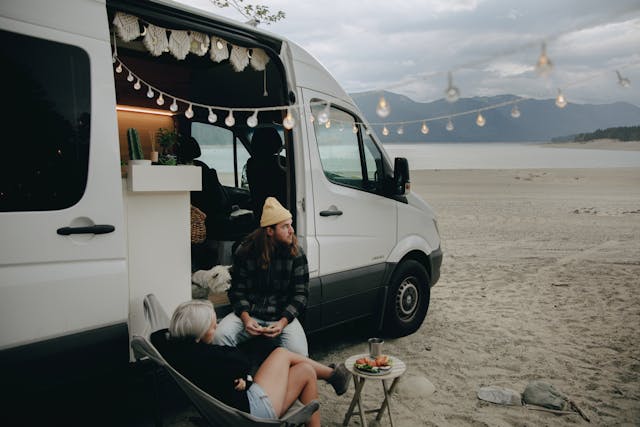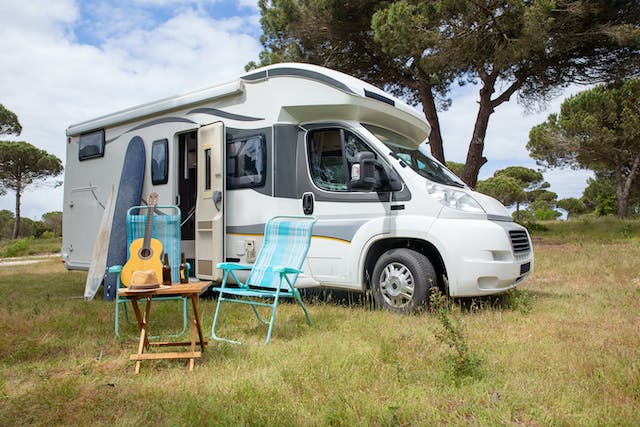The Ultimate Guide to Storing Your RV at Home
As summer swiftly fades into autumn and winter approaches, it’s time to consider what to do with your RV. Will you be storing it for the winter, renting it out, or fortunate enough to enjoy year-round RVing in favorable climates? For many, storing the RV becomes a necessity until the warmer months return.
While some opt for campground or storage facility storage, you may be considering keeping your RV at home for the winter. But is this the best choice for you? What preparations are necessary for both your home and RV? These are important questions to address.
In this comprehensive guide, I’ll explore every aspect of storing your RV at home, covering topics such as space requirements, maintenance, and more, to help you make informed decisions and ensure a smooth storage experience.
Advantages of Storing Your RV at Home
Why opt for storing your RV at home instead of a dedicated facility? There are several compelling reasons.
Firstly, let’s talk finances. Cost often dictates our choices, and RV storage fees can add up significantly. Outdoor facilities typically charge between $30 to $100+ per month, depending on size. Indoor storage, especially heated spaces, can run anywhere from $50 to $500 monthly.
Moreover, considering the long-term care of your RV is crucial. Not everyone can afford expensive indoor storage. Leaving your RV exposed to the elements can lead to wear and tear over time. Snow, rain, and cold temperatures can damage its exterior. Storing it at home allows you to maintain it regularly, ensuring its longevity.
Key Considerations before Storing Your RV at Home
So, you’re considering storing your RV at home for the off-season. Before you proceed, it’s essential to ponder the following questions:
1. Assessing Space: Can I Accommodate RV Storage at Home?
Determining whether you have adequate space to store your RV at home is paramount. Consider the dimensions of your property and the size of your RV carefully. Here are some factors to contemplate:
- Size of your RV: Class A motorhomes are typically larger and may require more space, especially if your home is single-story. Class B or Class C RVs are generally more manageable in terms of space requirements.
- Dimensions: Class C RVs range from 21 to 35 feet long, while Class Bs typically measure between 16 to 22 feet. If your RV exceeds 40 feet, accommodating it at home might not be feasible.
Evaluate your available space against the dimensions of your RV to determine if storing it at home is a viable option.
2. Choosing the Right Spot for RV Storage on Your Property
Deciding where to store your RV on your property is a crucial step. Consider these options:
- Driveway: Many opt for the driveway, but be mindful of space limitations, especially if you have multiple vehicles. Even smaller Class B or C RVs can occupy significant room.
- Garage: Storing your RV in the garage is an ideal solution, but it requires sufficient space and clearance. Prepare to clear out the garage to accommodate larger Class A or Class C RVs.
Evaluate your property layout and available space to determine the most suitable storage location for your RV.
3. Legal Considerations for Storing Your RV at Home
Before deciding to store your RV on your property, it’s crucial to consider the legal aspects:
- Homeowner’s Association (HOA) Rules: Many HOAs have restrictions on RV parking. Review your HOA guidelines to ensure compliance before storing your RV at home.
- Local Municipality Regulations: Check with your local government to understand any zoning or parking regulations that may apply to storing RVs on residential properties.
- Potential Consequences: Ignoring regulations could result in fines, tickets, or even having your RV towed. It’s advisable to clarify the legalities beforehand to avoid any penalties.
Ensure you’re aware of and adhere to all relevant laws and regulations to prevent any legal issues associated with storing your RV at home.
4. Ensuring Security and Protection for Your RV
Ensuring your RV’s safety and protection is paramount, especially when storing it at home:
- Protection from Elements: Storing your RV in a driveway without adequate shelter exposes it to the elements, negating the purpose of storing it at home. Ensure your storage spot provides protection against weather conditions.
- Safe Environment: Choose a spot that offers security for your RV. While a garage is ideal, any form of shelter that shields your vehicle from potential damage is beneficial.
Prioritize finding a secure and sheltered location on your property to safeguard your RV from environmental hazards and potential risks.
5. Assessing Long-Term Financial Savings
Consider the financial implications of storing your RV at home:
- Initial Renovation Costs: Converting your garage or preparing a storage spot at home may incur significant upfront expenses.
- Ongoing Expenses: Additional costs, such as maintenance, security measures, and potential HOA fees, can accumulate over time.
Evaluate these expenses against the cost of renting a storage spot at a facility. While storing your RV at home may seem cost-effective initially, consider the long-term financial implications to ensure you’re genuinely saving money in the end.
6. Considering Family and Neighbor Relations
Before storing your RV at home, consider the potential impact on your family and neighbors:
- Family Dynamics: Assess how storing the RV at home may affect your family members. Consider their feelings about seeing the RV parked on the property throughout the winter months.
- Neighbor Relations: Communicate with your neighbors to ensure they are comfortable with the presence of the RV. Address any concerns they may have regarding aesthetics or regulations.
Maintaining open communication with your family and neighbors can help prevent potential conflicts and ensure a harmonious living environment for everyone involved.
Mastering RV Parking: Tips for Driveways and Garages
When it comes to parking your RV, considerations extend beyond choosing between your driveway or garage. Factors like slope and layout can pose challenges:
- Driveway Slope: If your driveway is sloped, parking your RV may present difficulties. Uneven terrain can affect stability and maneuverability.
- Garage Angle: Similarly, if your garage is situated at an angle, maneuvering your RV into the space may require additional care and skill.
Navigating these challenges requires careful planning and execution. Consider employing leveling blocks or ramps to address slope issues, and practice parking maneuvers to ensure a smooth process.
Addressing Weight Distribution for RV Storage
Weight distribution is a critical consideration when storing your RV, especially if it’s parked at an angle. Here’s why:
- Potential Damage: Storing your RV on an incline can cause items inside to shift, leading to uneven weight distribution. This imbalance can strain axles and other components, potentially causing damage.
- Refrigerator Concerns: An uneven angle can impact the functioning of your RV refrigerator. Incorrect positioning may lead to the development of ammonia sediment within the cooling unit, hindering its performance. Excessive sediment can render the fridge inoperable, resulting in food spoilage.
To mitigate these risks, ensure your RV is parked on level ground to maintain proper weight distribution and fridge functionality. Regularly check and adjust the positioning of your refrigerator to prevent sediment buildup and ensure optimal performance.
Managing Wheel Blocks, Rooflines, and Neighbor Considerations
- Wheel Blocks: Use wheel blocks to prevent your RV from rolling on sloped driveways. Avoid parking on steep inclines or angles whenever possible to minimize this concern.
- Roofline Awareness: Be mindful of your home’s roofline, especially if your garage is adjacent to the house or located in a side yard. Ensure your RV is parked clear of any overhanging structures to prevent damage.
- Tree Clearance: Trim trees and foliage that may obstruct access to your driveway or garage. Clearing these obstacles before parking your RV will make maneuvering easier.
- Considerate Parking: Park your RV in a way that allows your neighbors to maintain visibility and access. Avoid obstructing views or parking near sidewalks to prevent potential hazards or legal issues.
By addressing these considerations, you can ensure safe and hassle-free RV parking while minimizing potential inconveniences for yourself and your neighbors.
Preparing Your RV for Winter Storage
As your RV settles in for the winter, it’s crucial to undertake proper winterization to ensure it remains in optimal condition for the spring. Here’s a comprehensive checklist to guide you through the process:
Taking Care of Faucets, Drains, and Pumps During Winterization
- Pressurize the Water Pump: Start by ensuring the water pump is on. Then, systematically open each faucet, one at a time, including both hot and cold water valves, to pressurize the system with antifreeze. Confirm antifreeze flow at each faucet.
- Change Water Inlet Screen: Power down the water pump and open a faucet to release pressure. Remove the water inlet screen and replace it with a new one to maintain optimal flow.
- Seal Off Faucets: Close off all faucets throughout the RV, including those in the bathroom, kitchen, and any others to prevent freezing.
- Treat Drains with Antifreeze: Pour approximately one cup of antifreeze into each drain to prevent freezing in colder temperatures.
- Address Holding Tanks and Toilet: Add a larger quantity of antifreeze (about two to three cups) to black water and gray water tanks, as well as the toilet. Flush the toilet until antifreeze is visible in the water to ensure thorough treatment.
- Install a Water Heater Bypass Kit: Consider installing a water heater bypass kit to prevent antifreeze from entering the water heater, which could lead to unnecessary waste.
- Manage Low Point Drain Lines: Do not use low point drain lines once the water pump is turned off for the season, as they may interfere with efficient antifreeze distribution.
Caring for Heaters and Seals During Winterization
- Disable Electric Heating Elements: Power down any electric heating elements in your water heater. While you don’t necessarily need to unplug them, ensure they are not in use. Consider removing the electric heating element and storing it outside the RV for the winter to prevent accidental activation.
- Empty the Water Heater: Turn off the water heater and allow it to cool for several hours before proceeding. Once cooled, release all water from the heater through the pressure relief valve accessed via the drain plug. This process ensures the water heater is fully emptied and ready for winter storage.
- Inspect Seals: Thoroughly examine all seals both inside and outside the RV, paying particular attention to those around windows and doors. Look for any signs of damage such as holes or cracks. If any problem areas are identified, apply new caulk to seal them properly. Failing to do so can lead to infestations by insects, rodents, and other pests during the winter months.
- Check Roof Vents: Ensure that all roof vents are properly sealed to prevent water infiltration. Inspect the seals around roof vents and reseal them if necessary to maintain a watertight seal.
Preparing Plumbing, Interior, and Electrical Systems for Winter Storage
- Inspect Air Conditioner Plumbing Vents: Check air conditioner plumbing vents for leaks or signs of damage. Address any issues before storing your RV for the winter to prevent further damage.
- Remove Furniture and Linens: Take out all removable furniture and strip beds of linens. Ensure no clothing, blankets, or other garments are left inside the RV.
- Empty Cabinets and Food Storage Areas: Clear out all cabinets, drawers, and shelves of food items, including bottled, canned, or processed food. Remove all trash from the RV.
- Clean Interior Surfaces: Wipe down cabinets, refrigerator, freezer, stovetop, microwave, and oven to remove any crumbs or food residue that could attract pests.
- Prepare Refrigerator and Freezer: Unplug the refrigerator and freezer and allow them to dry out. Place baking soda in the fridge to absorb odors.
- Manage Propane Tanks: Remove propane tanks from the RV and store them in a safe location, such as a garage, to prevent potential hazards.
- Disconnect Electrical Systems: Turn off the circuit breaker and disconnect from shore power. Remove batteries from external electrical devices, including alarm clocks, smoke detectors, radios, and clocks.
- Remove Expensive Electronics: Take gaming systems, TV, and other valuable electronics indoors for safekeeping.
- Disconnect and Store Battery: Unplug the battery and take it with you for storage in a safe location.
Preparing Engine, Tires, and Exterior Parts for Winter Storage
- Use Fuel Stabilizer: Add fuel stabilizer to the engine to reduce the risk of excessive condensation and fuel degradation during storage. Run the engine while adding the stabilizer to ensure it disperses throughout the system effectively.
- Antifreeze for Windshield Washer: Add antifreeze to the windshield washer solution to prevent freezing and damage to the system.
- Use Leveling Jacks: Consider using leveling jacks to elevate the RV’s tires off the ground slightly. This prevents flat spots from forming on the tires during extended periods of inactivity. Ensure the RV is securely stabilized if using leveling jacks to prevent accidents or damage.
Important Considerations for Off-Season RV Storage
As you contemplate where to store your RV during the off-season, it’s essential to carefully consider the following points. I’m sharing these not to dissuade you from parking your vehicle at home but to ensure you have all the necessary information to make an informed decision. By weighing these factors, you can determine the best course of action for both your RV’s well-being and your financial interests.
Dealing with Bugs, Insects, and Critters
No location is immune to the presence of bugs and insects, especially when your RV is parked outdoors. Whether you opt for an outdoor storage facility or your garage, vigilance against these pests is essential. They can infiltrate your RV through even the smallest openings.
Sealing off all entry points, as previously discussed, is crucial. Additionally, ensure your RV is completely free of food remnants, including wrappers and packaging, as these can attract bugs and insects.
But insects aren’t the only concern; there are also critters seeking shelter in your RV during the colder months. Rats, mice, bats, and raccoons are among the common intruders. These animals are drawn to the warmth and protection your RV offers, making it an enticing refuge.
Rats and mice, in particular, can wreak havoc on your RV’s interior, causing damage to furniture, upholstery, wiring, and other surfaces, while leaving behind droppings and messes.
If pests find their way into your home, they can easily make their way into your RV as well. Regular inspections for insects and critters are necessary, regardless of whether your RV is parked in your garage or driveway, to prevent infestations during the winter months.
Enhancing Security for Your RV
When your RV is parked in your driveway, exposure to the elements isn’t your only concern. There’s also the risk of vandalism, destruction, and theft.
You might think, “I live in a safe neighborhood, so I don’t need to worry about vandalism or theft, right?” However, RVs are valuable assets, and unfortunately, they can attract unwanted attention from individuals looking to make a profit.
Considering the significant investment an RV represents, it’s prudent to explore security measures for your vehicle. This could involve installing security systems in and around your RV. While this can entail some expense, ranging from several hundred to several thousand dollars depending on the technology used, it’s a worthwhile investment in safeguarding your asset.
The need for security measures is particularly relevant when your RV is exposed in your driveway. If you can store it in your garage, it’s less vulnerable to theft or vandalism, although not entirely immune.
By taking proactive steps to enhance security, you can better protect your RV from potential threats and enjoy greater peace of mind.
Considering Gating Your Property for RV Security
If your RV can’t fit into your garage, gating your property is another security option to consider. While it’s not a budget-friendly choice, it can significantly reduce the risk of vandalism and theft.
A gated property acts as a deterrent to potential criminals, making it less appealing for them to target your RV. While it’s not a foolproof security measure, it adds an extra layer of protection that’s worth considering.
Proper Storage for Your RV Battery
I’ve emphasized the importance of caring for your RV battery before, but it’s worth repeating. Proper maintenance includes removing the battery during the winter months. Leaving it in your RV risks freezing, resulting in a lack of electricity when you return to your vehicle.
Even when removed, the battery’s storage conditions are critical. Extreme temperatures, whether overly cold or hot, can render the battery useless. To avoid this, store the battery in a location with moderate temperatures, shielded from direct sunlight. Place it on plywood or another surface, rather than directly on the ground, to prevent damage.
Additionally, ensure the battery is regularly charged, aiming for around 80 percent capacity to maintain its health during storage. Following these steps will help preserve your RV battery’s functionality and longevity.
Protecting Your RV with a Cover
If your only option is to park your RV in the driveway, investing in a cover is a wise choice. A quality cover provides protection against various elements such as rain, wind, snow, and sun exposure, helping to prevent external damage and sun fading. Additionally, it offers insulation, aiding in temperature control and keeping the RV relatively warm during winter.
However, it’s essential to note that RV covers may not be entirely insect or critter-proof. Determined pests like mice or rats can potentially chew through fabric covers. To mitigate this risk, consider applying critter repellant to the cover to deter unwanted visitors. This extra step can help safeguard your RV from potential damage caused by pests.
Another Alternative—Rent Out Your RV
Instead of storing your RV during the off-season, consider renting it out to others. Platforms like RVShare offer a straightforward process for listing your RV or camper for rent in your local area, similar to Airbnb but tailored for recreational vehicles. This option allows you to maximize the use of your RV while generating additional income.


